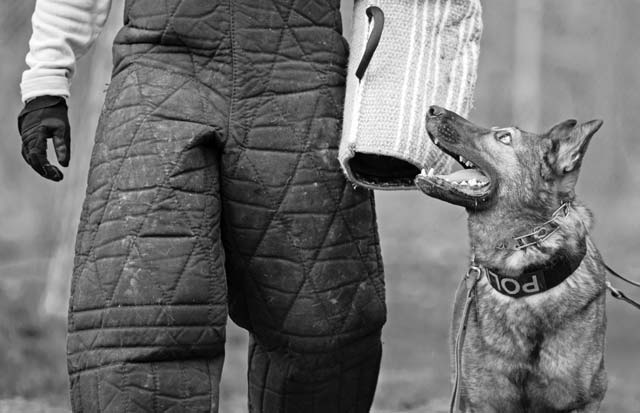
Ensuring the safety of the public, standing vigilant and being constantly on the lookout for danger is the way of the military working dog.
Sacrificing a life of luxury to be a hero among men and beast alike, bringing freedom to those who wish to have it, and guarding against those who want to take that freedom away is also the way of a military working dog.
These elite K-9s undergo up to 120 days of extensive training to learn various commands and how to better hone their senses, but their true potential isn’t revealed until a bond is made with a handler.
“The K-9 we’re assigned is our partner,” said Senior Airman Michael Sayre, 86th Security Forces Squadron military working dog handler. “We need to have confidence in them and they need to be able to trust us. Our main job is to find explosives and narcotics, and that’s hard to do as a handler and dog if we didn’t trust each other. That bond has to be instilled, otherwise the mission wouldn’t be accomplished effectively.”
At Ramstein, handlers are given two to three weeks to focus on their new partner, learn their mannerisms and build initial trust.
“When I was first assigned Charly I would take him for walks, play fetch and even go in his kennel with him,” Sayre said. “Treating him like a real dog rather than a military working dog where it’s all work, work, work really makes a noticeable difference in attitude and performance.”
Once a K-9 learns how to work with its handler, it undergoes more training, preparing it for any threat at home or abroad. The various courses the dogs undergo simulate what they might encounter during a mission.
“The concrete slab with a square hole in the middle mimics a window, the tubes they go through act as a constricted area, and the stairs they go up and down show us that they can traverse a rocky hill, do the job and get down safely,” Sayre said. “Everything has its purpose, and we do all we can to prepare them for a stressful deployment.”
Though the K-9s go through vigorous training to become better equipped, no hero is successful without a disciplined sidekick. Each handler is taught additional skills from their kennel master trainer.
“Once an Airman has been a handler for at least 18 months they can be selected to go to the kennel master trainer course, and from there, we are taught how to instruct and pass on the knowledge we have learned throughout the years,” said Staff Sgt. Michael Judy, 86th SFS MWD trainer.
Though one day the leash must be left behind to advance in this career and teach new dog teams, there is a certain satisfaction that comes with being a trainer that is rarely received any other way.
“It is really hard to give up the leash, but as a trainer I receive a lot of pride in seeing the K-9s and handlers grow not only as individuals but also as a team,” Judy said. “That feeling of accomplishment is better than any award.”


